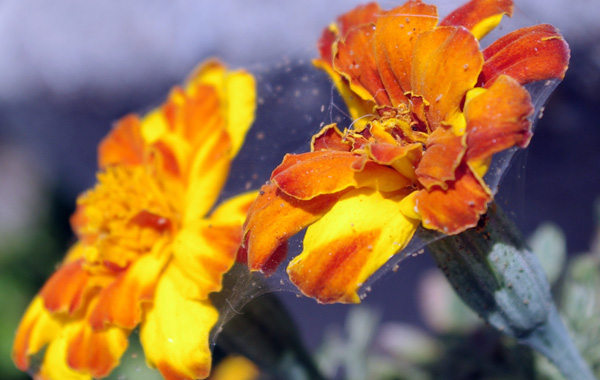 sotry by char vandermeerOctober’s waning days and crisp evenings provide welcome relief from the summer’s brutal heat, but it’s a bittersweet reward: The summer’s bounty is already nothing more than a bright delicious memory, and your garden is largely in hibernation. If your recall is anything like mine, though, it’s a great time to document your gardening triumphs and your brown thumb travails before March hits and you think, “Now, what was it that I was going to do to keep my tomatoes alive? Dance naked in the moonlight while chanting the lyrics to ‘Eye of the Tiger’? Or was it something about marigolds?” So, pull out that frilly journal from Aunt Sally and take a few notes. Your neighbors will appreciate it. And now, a few lessons learned on a little blue South Philly deck:
sotry by char vandermeerOctober’s waning days and crisp evenings provide welcome relief from the summer’s brutal heat, but it’s a bittersweet reward: The summer’s bounty is already nothing more than a bright delicious memory, and your garden is largely in hibernation. If your recall is anything like mine, though, it’s a great time to document your gardening triumphs and your brown thumb travails before March hits and you think, “Now, what was it that I was going to do to keep my tomatoes alive? Dance naked in the moonlight while chanting the lyrics to ‘Eye of the Tiger’? Or was it something about marigolds?” So, pull out that frilly journal from Aunt Sally and take a few notes. Your neighbors will appreciate it. And now, a few lessons learned on a little blue South Philly deck:
Let’s begin with an ode to marigolds. They smell funny and they’re kind of ugly. But the former is caused by terpene, an organic compound found in turpentine, and it’s magic! Those garish, tough yellow flowers? They really do lure whiteflies away from innocent tomatoes and attract small swarms of pollinating bees to your cucumbers. I’m totally a convert. Plus, they’re super cheap, and can often be found on clearance racks for pennies apiece. The stinkier they are, the better they work—so look for African marigolds, as they’re the most pungent. You’ll want to deadhead (aka pluck fading blooms) regularly to encourage summer-long flowering. I just chucked the deadheads into various cucurbit pots, hoping the residual scent would continue working its aphid-be-gone magic.
Mulching seems like a no-brainer, but it’s tempting to get those plants in the ground and call it a day. Don’t. Good mulch not only helps keep your crops cool and moist during the hottest days, but it also minimizes fungus and mildew caused by splashback from frequent watering and heavy rainfall. This year I put down a liberal coating of cedar mulch, which may also have natural bug-repelling capabilities (again, the more potent-smelling, the better), and everything appeared happier for it. Of course, I’m not sure we got any appreciable rain throughout June or July, which may also have had a hand in keeping mildew and fungal growth to a minimum. In addition to cedar bark, though, the mulch surrounding the precious melons and cucumbers was laced with gently used aluminum foil, which is purported to repel aphids and other creepy crawlies by reflecting light and critter-frying heat.
As you may have gathered, aphids were the scourge of the deck last summer, and thanks to last year’s note-taking, this year’s precautionary measures kept things relatively aphid-free. In addition to the marigolds, a ruthless killing hand was employed: As soon as the green nasties reared their crop-eating heads on tender, aphid-favorite lettuce leaves, the lettuce was plucked, rinsed and eaten. The container the lettuce was growing in had a date with hot soapy water, and was retired for the duration of the cucumber and melon season. Priorities, people.
And finally, a word about dirt. If you’re going the all-organic route, try to contact the company you plan on purchasing your soil from. Make sure the pH and nutrient levels are right for growing vegetables. This year, I bought about 100 pounds of locally produced organic potting soil, only to have everything planted in that soil wither and die. The pH was too high to support optimal vegetable growth and, strangely, the salt levels were too high to support much of anything. Other plants, plopped in not-so-holy, comparatively inexpensive, mass-produced soil, churned out pounds and pounds of lovely, tasty veggies.
Char Vandermeer tends a container garden on her South Philly roof deck; she chronicles her triumphs and travails at plantsondeck.com.

